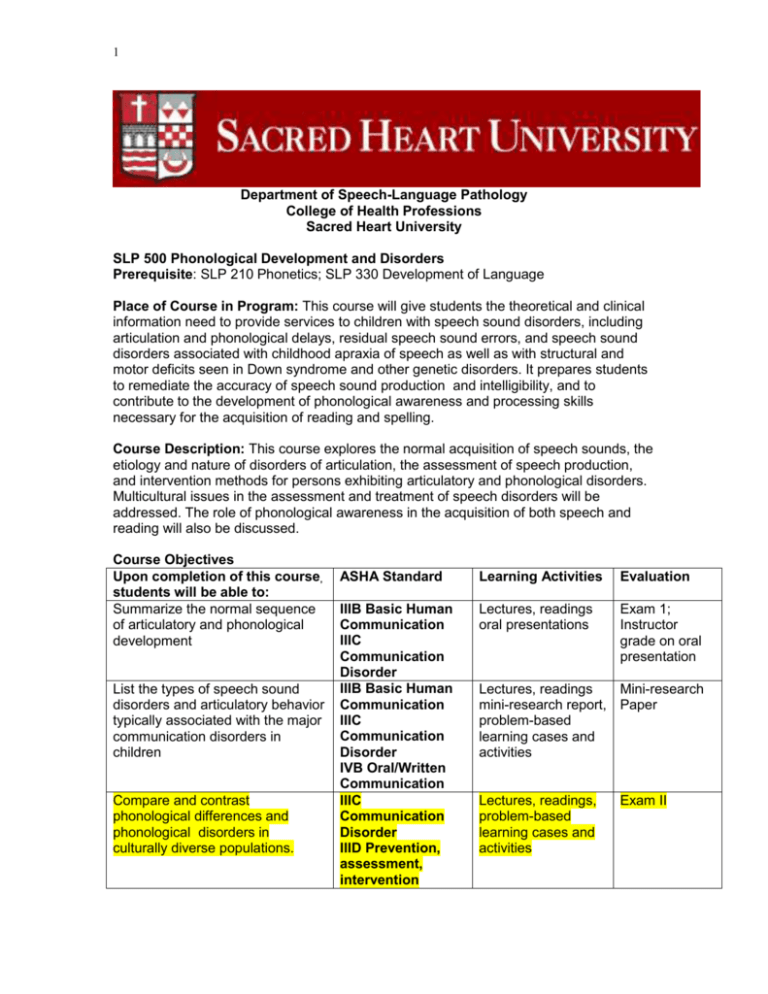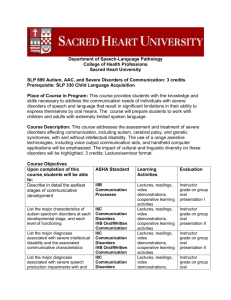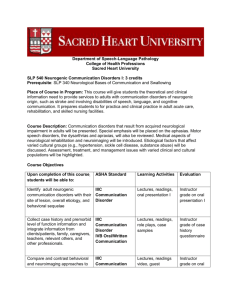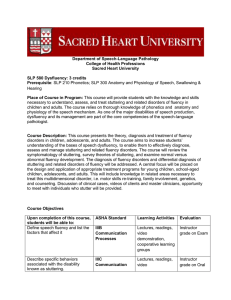SLP 500 Phonological Development & Disorders
advertisement

1 Department of Speech-Language Pathology College of Health Professions Sacred Heart University SLP 500 Phonological Development and Disorders Prerequisite: SLP 210 Phonetics; SLP 330 Development of Language Place of Course in Program: This course will give students the theoretical and clinical information need to provide services to children with speech sound disorders, including articulation and phonological delays, residual speech sound errors, and speech sound disorders associated with childhood apraxia of speech as well as with structural and motor deficits seen in Down syndrome and other genetic disorders. It prepares students to remediate the accuracy of speech sound production and intelligibility, and to contribute to the development of phonological awareness and processing skills necessary for the acquisition of reading and spelling. Course Description: This course explores the normal acquisition of speech sounds, the etiology and nature of disorders of articulation, the assessment of speech production, and intervention methods for persons exhibiting articulatory and phonological disorders. Multicultural issues in the assessment and treatment of speech disorders will be addressed. The role of phonological awareness in the acquisition of both speech and reading will also be discussed. Course Objectives Upon completion of this course, students will be able to: Summarize the normal sequence of articulatory and phonological development List the types of speech sound disorders and articulatory behavior typically associated with the major communication disorders in children Compare and contrast phonological differences and phonological disorders in culturally diverse populations. ASHA Standard Learning Activities Evaluation IIIB Basic Human Communication IIIC Communication Disorder IIIB Basic Human Communication IIIC Communication Disorder IVB Oral/Written Communication IIIC Communication Disorder IIID Prevention, assessment, intervention Lectures, readings oral presentations Exam 1; Instructor grade on oral presentation Lectures, readings Mini-research mini-research report, Paper problem-based learning cases and activities Lectures, readings, problem-based learning cases and activities Exam II 2 IIIG Professional Issues IVB Oral/Written Communication IVF Diverse Backgrounds IIIC Administer, score, and interpret Communication assessment procedures for evaluating speech sound disorders Disorder IIID Prevention, and intelligibility assessment, intervention IIIE Ethics IIIF Evidencebased Practice IVF Diverse Backgrounds IVB Oral/Written Communication IIIC Summarize and evaluate Communication intervention strategies for speech Disorder sound disorders IIID Prevention, assessment, intervention IIIE Ethics IVB Oral/Written Communication IVF Diverse Backgrounds Summarize, compare and contrast past and current theories of phonological development IIIB Basic Human Communication IIIC Communication Disorder Lectures, readings, problem-based learning cases and activities Problem-based Case study report Lectures, readings, problem-based learning cases and activities Problem-based Case study report Lectures, readings, class debates Exam 1 Readings Bauman-Waengler, J. (2011). Articulation and Phonological Impairments: A Clinical Focus-4th Ed. Boston: Allyn & Bacon. Course Requirements and Grading Criteria Assignments Points Exam I 25 Exam II 25 3 Oral presentation 10 Mini-research Paper 20 Problem-based Case Study Part I 10 Problem-based Case Study Part II 10 Total Possible Points 100 SHU Grade Criteria Letter Grade Grade Range Grade Points A 93-100 4.0 A90-92 3.67 B+ 87-89 3.33 B 83-86 3.00 B80-82 2.67 C+ 77-79 2.33 C* 73-76 2.00 C-* 70-72 1.67 D+* 67-69 1.33 D* 60-66 1.00 F 0-59 0.00 *Note: the following grades are not available for Graduate Courses: C-, D+, D Course Policies Academic Honesty: A standard of honesty, fairly applied to all students, is essential to a learning environment. Students abridging a standard of honesty must accept the consequences; penalties are assessed by appropriate classroom instructors or other designated people. Serious cases may result in discipline at the college or University level and may result in suspension or dismissal. Dismissal from a college for academic dishonesty, constitutes dismissal from the University.(University Student Handbook) Attendance and Class Participation: Students are expected to attend each class-attendance will be taken. Each student is expected to read assigned material prior to class and participate in class discussions. Students may be called on to answer questions and provide opinions during discussions. Students who miss class are responsible for content. Any student who misses a class has the responsibility for obtaining copies of notes, handouts, assignments, etc. If additional assistance is still necessary, an appointment should be scheduled with the instructor. Class time is not to be used to go over material with students who have missed class. Submission of work taken directly from another source (e.g. lesson plan copied from a book, the internet, or material developed by another student) will be considered plagiarism and grounds for no credit on the assignment. Students are encouraged, however, to use a variety of resources in obtaining ideas and illustrations that will help them complete assignments independently. See the APA Guide for the correct method to cite other authors' work. University policy dictates that students must seek the instructor's permission to record class lectures. 4 All cell phones/pages must be turned off during class time. Students are required to show conduct consistent with professional standards as discussed in class when conducting on-site observations. Work done outside of class must be reasonably correct in mechanics (e.g. spelling, grammar, punctuation, etc.). Points will be deducted for inadequate work. All typed assignments completed outside of class must be double-spaced, using Times, Times New Roman, or Arial font. All font sizes for typed assignments must be size 11-12. Any font size less than 11 or larger than 12 will be returned for re-typing to required font size. APA style is required for written papers, including table, figure, and graph formats, references and citations, and appropriate professional language use. In ALL work, use person-first language to be consistent with IDEA. Emphasize the person more than the disability (i.e., a child with Down syndrome, NOT a Down syndrome child). Student work will be returned as promptly as possible. All assigned work is due at the beginning of class on the due date designated in the course syllabus. Work submitted late will receive an automatic 5-point reduction from the earned grade. Students are encouraged to submit all assignments on time. Competency: In this course, your knowledge will be assessed on the appropriate portions of the exams, or other assignments. Competency of 80% or better on these assessments is necessary to meet certification standards of the Council for Clinical Certification in Audiology and Speech-Language Pathology. Students failing to attain the set criteria on a required competency assessment will be provided a remediation plan and an additional attempt to pass the competency. If students do not pass the competency a second time, one additional remediation will be provided. For students failing to attain the set criteria on a required competency assessment after the third attempt, the department and university are not able to recommend their application for ASHA certification and state licensure, even though they may receive an acceptable course/clinic grade or exceed the minimum GPA. ADA Policy Students with disabilities needing academic accommodation should register with and provide documentation to Jandersevits Learning Center; no accommodations can be provided without written recommendations from the JLC.







